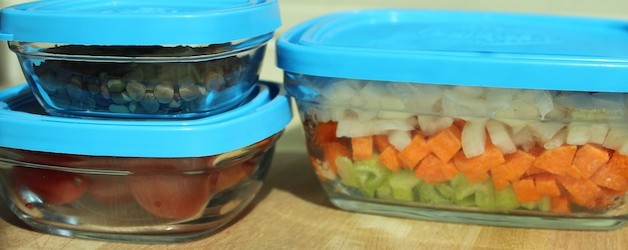

If you follow the Table365 Feeding Your Family System, you’re guaranteed to save TIME and MONEY and reduce your stress over the daily task of feeding your family. Now that you have worked so hard to feed your family by setting your goals, planning your meals, stocking your pantry and freezer, and preparing delicious meals, the last thing you want to have happen is for your food to spoil because it isn’t stored properly. Having the right containers for storage in your pantry, refrigerator, or freezer is as important a step in feeding your family as all the others you have taken.
You only have to walk through the food storage departments of places like the Container Store (one of Kimberly’s favorite places) or Bed, Bath, and Beyond to understand the variety of styles and materials available. Crate and Barrel does a good job curating if you feel overwhelmed by the selection and want some quality choices that are narrowed-down.
You may want containers in your pantry that stack well, or ones in your freezer that save space, or ones in your refrigerator that are see-through. No matter the style or material you choose, the most important factor for any food storage is a tight seal that will keep air out.
So, aside from making sure the options you choose are airtight, here are some features to consider:
- Stackable.
- Secure lids.
- Aesthetic preferences.
- Glass v. Plastic – the main consideration is if you plan to reheat your food in the container you pack it in. If so, then we recommend glass.*
Here are a few specific ideas/tips for storing food in your pantry, refrigerator, or freezer:
Pantry Storage
- Stackable: pantry storage can be at a premium, so stackable containers are a great option.
- Labels: use uniform labels to keep your pantry looking organized and uncluttered, even if you don’t have the same containers for everything. There are lots of options, from practical paper labels to charming chalkboard labels.
Refrigerator Storage
- Kitchen essentials like foil, parchment paper, and zip-top bags are all convenient alternatives to containers.
- Leak proof: make sure whatever you use won’t leak, especially any zip-top bags.
- Easy labeling: to keep track of use-by dates on either your own containers or purchased jars or packages, keep a dry erase marker handy to label.
Freezer Storage
- Foil and butcher paper (heavy duty freezer paper): good options for wrapping dry, solid foods.
- Plastic containers: there are lots of options that can be used in the freezer, but we don’t recommend using these containers for later cooking or reheating.
- Ice cube trays: these are great to use for freezing small amounts, and you can transfer frozen cubes into a zip-top bag or other freezer container. As with other plastics, be mindful of looking for BPA-free products.
- Zip-top bags or vacuum packed bags: since space-saving and airtight seals are big concerns for freezer storage, zip-top bags or vacuum seal bags (these require a special machine) that you can store flat (or horizontally once everything inside is frozen) can be helpful. One bonus to these options is that since you can freeze items flattened out, they are easier to defrost.
- Glass: if you choose to freeze something in glass, make sure it is a “freezer safe,” or “freezer-to-oven safe” if you plan to reheat or cook something in that container. One option available are Anchor Hocking Bake ‘N’ Store Glass Dishes.
Reducing the Risks of BPA in Plastic Storage
*There is a lot of debate about the safety of plastics containing BPA for food storage. It is a chemical byproduct of plastic production and is used in so many items we are in daily contact with that there is no getting around it. Many plastic containers and aluminum cans contain BPA (the cans are lined with a BPA product). Even though many products contain BPA, there are ways to reduce your exposure in the kitchen:
- Many companies are now making products that are BPA free.
- When plastic is heated, the BPA in the material begins to break down and leach into the food. So, cool all foods before putting in plastic containers or bags that are not BPA-free. Do not reheat frozen or refrigerated foods in plastic.
- Because heat releases BPA from plastic containers, hand washing plastic is recommended, or wash it on top rack in a dishwasher only.
- If you are not sure if a plastic container contains BPA, look for the little triangle icon on the bottom (this is the “resin identification number” that most of us use to determine if we can recycle a container). Although not all plastics with the number 7 contain BPA, it is still a good indicator. A container with BPA may also have “PC” on it (for polycarbonate).
Now all the steps from goals setting to storage are outlined to support you in feeding your family. We’ll still be here working to share inspiration and fresh ideas with you. Let us know how we can help!
Cheers,
